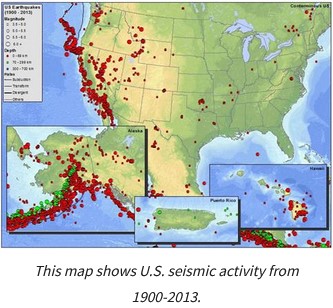
You’ve got a lot to do to get completely ready for the next big quake,
so you need to meet with your family or roommates and prioritize.
Here are some of the fastest, easiest, low cost (but still important) things to do to get ready for an earthquake.
Consider doing these today:
Always make it a habit to drive with at least a half full tank of gas. When the power is off after an earthquake and often during howling winter rain / windstorms, gas stations can’t pump gas.
Buy flashlights (electric torch), spare batteries and bulbs. Put a flashlight by each person’s bed, and in each vehicle glove compartment, your desk at work. (When we go camping & hiking we always have a small flashlight in each persons pocket.) Your cell phone will not function well enough or long enough as a flashlight.
Shoes right next to each person’s bed as broken glass will be everywhere after the quake and being barefoot could be dangerous.
Evacuation plan, and find a place in each room to take cover, two exits from each room. Practice this plan with children.
Move the bed away from the window; take down pictures, mirrors over the head of the bed, on a wall over couches.
Move delicate objects to lower shelves. Move pet cages as necessary.
Take a photo of you and your pets on your cell phone. (A current picture of you and your pet together can help prove ownership.)
Take photos of family members together on your cell phone.
Store important phone numbers somewhere besides just your cell phone.
Do these in the next few days:
Tour the house, including the crawl space, looking for problems and write a list of plans/priorities for the next month (see link at the end of this page).
Start video taping and photographing the house and valuables.
Designate an out-of-state disaster contact.
Make an appointment to get your vaccinations (especially tetanus), and pet vaccinations up to date.
At work: flashlight (electric torch), walking shoes, work gloves, snacks, bottle of drinking water, manual can opener, etc.
Register for a first aid and/or CPR class.
Locate that crescent wrench.
Start storing water as appropriate containers become empty.
Buy polypropylene longjohns and fire extinguisher(s).
Choosing and Using Fire Extinguishers
https://www.usfa.fema.gov/prevention/home-fires/prepare-for-fire/fire-extinguishers/index.html
Make up the list of important phone numbers for next to the home and work landline phones, and list of emergency #s for the cell phone.
Pets may not be allowed at emergency shelters due to health regulations, etc. (Service animals specifically trained to aid a person with a disability might be allowed). Get written proof of current vaccinations from your vet (maybe at least rabies, distemper, parvo, and bordetella, ask the vet). Keep a list of pet-friendly hotels outside your immediate area in case you have to relocate. If there are none, contact other hotels and ask if they would waive their no pet policies after a disaster, or contact friends and relatives in advance.
Start locating and copying / downloading important documents.
Stock up on food, especially easy to eat, high quality snacks. Make having extras of things you can’t do without a habit (diapers, etc.).
Mark a calendar to practice evacuations plans, check smoke alarms, etc. every six months.
Fill empty space in the freezer with containers of water (only add one a day so you won’t melt the existing food).
(“Frozen Food and Power Outages: When to Save It and When to Throw It Out. A full freezer will hold a safe temperature for approximately 48 hours (24 hours if it is half full and the door remains closed). Food may be safely refrozen if . . . “) https://www.foodsafety.gov/food-safety-charts/food-safety-during-power-outage
Find out where the nearest pay phones are.
Learn how to use the manual release lever on the electric garage door opener that won’t work when the power is out.
Find the battery operated radio and get more batteries for it, or (maybe) get a solar/handcrank radio.
Get an auxiliary battery (external battery that plugs into the phone) for your cell phone and keep it charged. ( You will also find this useful for during vacation trips.)
____________________________________________
It can be worthwhile to use preparing for an earthquake as an excuse to get to know neighbors better or to get to know neighbors you may not have met yet.
Do neighbors have skills such as medical, technical, carpentry? Do they have special ‘tools’, such as chain saws or a T.V in a motorhome to watch footage of the quake on, or a ham radio? Consider how you would help those with special needs, such as elderly or disabled. Can you volunteer to help take care of kids who may be on their own if parents can’t get home?
______________________________________________
A family (and babysitters, caregivers, overnight guests) disaster plan, including details about much of the above, is at:
______________________________________________
As a part of preparing for the next earthquake, do a what if? survey of your home, crawl space, attic (again, including details about much of the above),
earthquake home hazards survey
______________________________________________
You can find detailed maps (with zoom in capability) of potential road closures, risk of liqufaction and flooding, such as this map of potential Bay Area road closures after a San Andreas fault 7.2 quake,

at the ABAG link at: Earthquake information sources
Helping Children Cope With Disaster
Store water for after an earthquake
Babysitter Consent and Contact Form
hazardous household chemical mixtures
myths about earthquakes
https://www.usgs.gov/faqs/what-triangle-life-and-it-legitimate
The author of this webpage, (written as a homework reading assignment for my students), does not give any warranty, expressed or implied, nor assume any legal liability or responsibility for the accuracy, completeness, or usefulness of any information, product, or process included in this website or at websites linked to or from it. Users of information from this website assume all liability arising from such use.